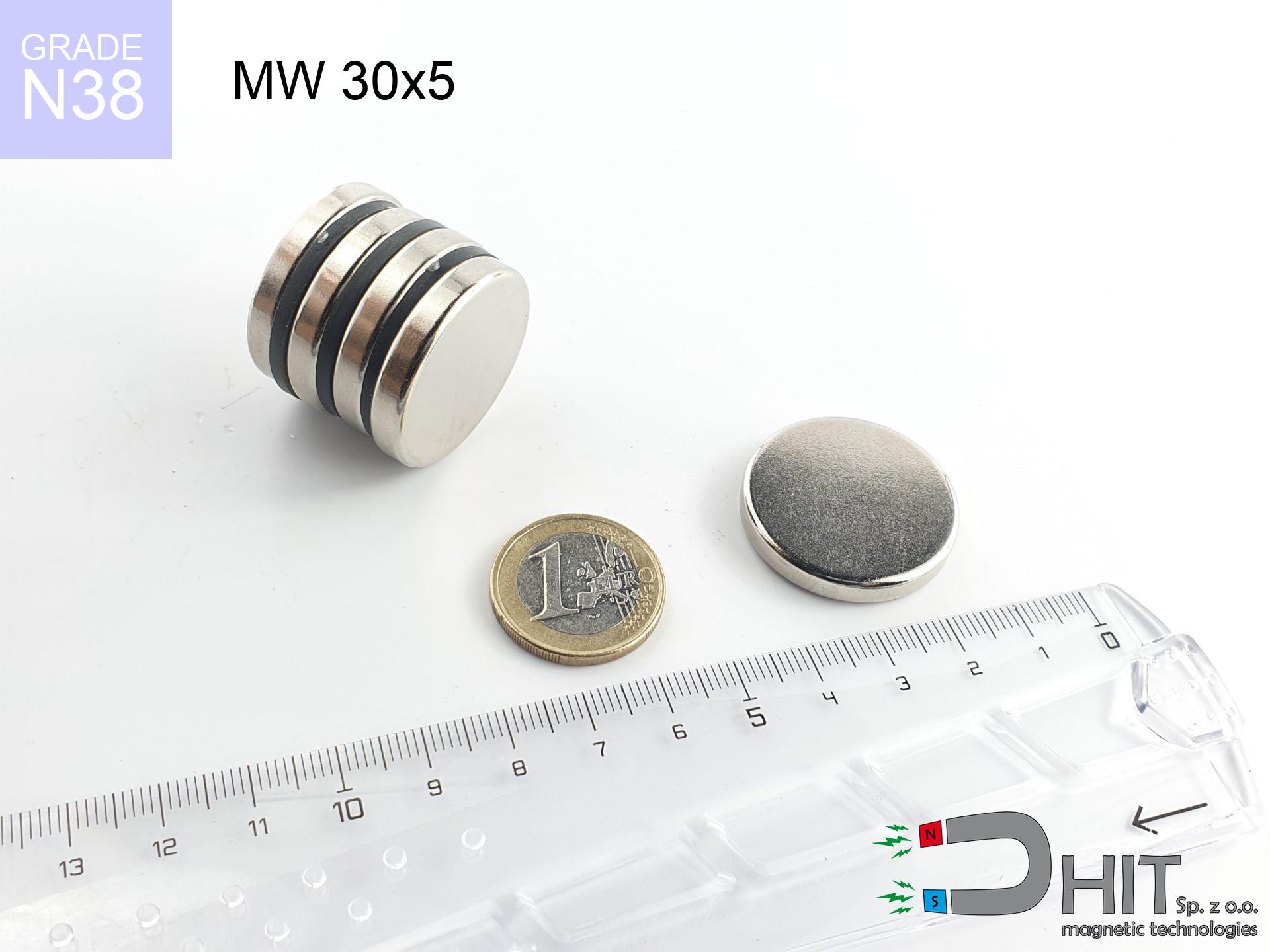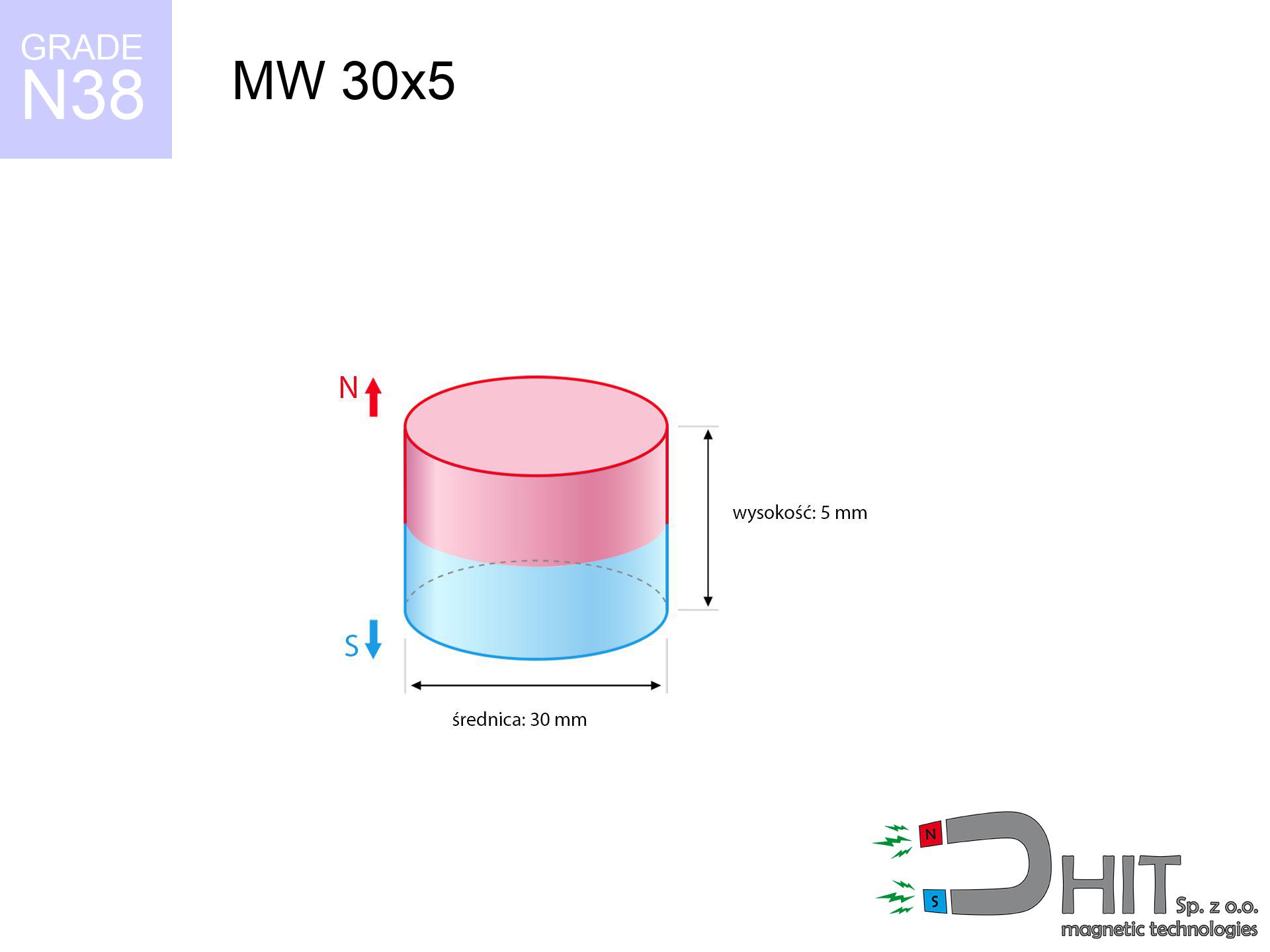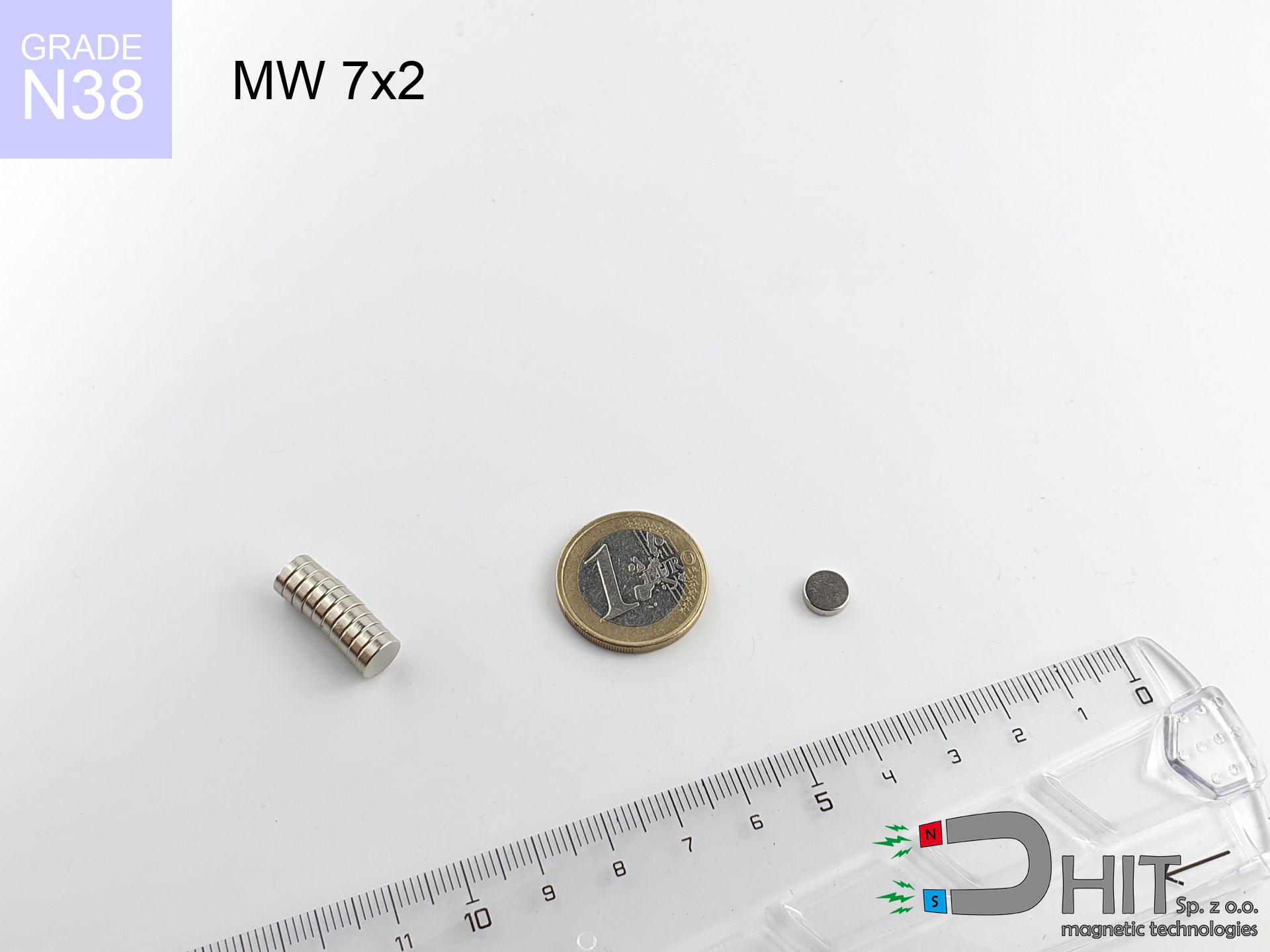MW 30x5 / N38 - neodymium magnet
cylindrical magnet
catalog number 010056
GTIN: 5906301810551
diameter Ø
30
mm [±0,1 mm]
height
5
mm [±0,1 mm]
magnetizing direction
↑ axial
capacity ~
8.29 kg / 81.30 N
magnetic induction ~
196.02 mT / 1,960 Gs
max. temperature
≤ 80
°C
catalog number 010056
GTIN: 5906301810551
diameter Ø
30 mm [±0,1 mm]
height
5 mm [±0,1 mm]
magnetizing direction
↑ axial
capacity ~
8.29 kg / 81.30 N
magnetic induction ~
196.02 mT / 1,960 Gs
max. temperature
≤ 80 °C
7.70 ZŁ gross price (including VAT) / pcs +
6.26 ZŁ net price + 23% VAT / pcs
bulk discounts:
need more quantity?Want to talk about magnets?
Give us a call tel: +48 888 99 98 98 or get in touch via form on our website. You can check the power and the shape of magnet in our magnetic calculator power calculator
Orders placed by 2:00 PM will be shipped on the same business day.
Specification: cylindrical magnet 30x5 / N38 ↑ axial
Magnetic properties of the material N38
Physical properties of sintered neodymium magnets Nd2Fe14B
Moreover, although neodymium is a component of the strongest magnets, they are susceptible to corrosion in humid environments. Therefore, they are coated with a coating of gold to protect them from corrosion. It's worth noting that NdFeB neodymium magnets are about 13% lighter than SmCo magnets and, despite their power, are brittle, which requires special caution during their handling. Therefore, any mechanical processing should be done before they are magnetized.
In terms of safety, there are several recommendations regarding the use of these magnets. They should not be used in acidic, basic, organic environments or in solvents, as well as in water or oil. Furthermore, they can distort data on magnetic cards and hard drives, although data deletion using a neodymium magnet is not always certain.
In terms of properties in different environments, neodymium magnets are sensitive to corrosion, especially in conditions of high humidity. Therefore, they are often coated with thin coatings, such as epoxy, to preserve them from environmental factors and prolong their durability. High temperatures exceeding 130°C can result in a deterioration of their magnetic strength, although there are particular types of neodymium magnets that can withstand temperatures up to 230°C.
As for risks, it is important to avoid using neodymium magnets in acidic environments, basic conditions, organic or solvent environments, unless they are insulated. Additionally, their use is not recommended in water, oil, or in an atmosphere containing hydrogen, as they may lose their magnetic strength.
Recommended articles for purchase
Advantages and disadvantages of neodymium magnets NdFeB.
In addition to immense strength, neodymium magnets have the following advantages:
- They do not lose strength over time. After 10 years, their power decreases by only ~1% (theoretically),
- They are extremely resistant to demagnetization by external magnetic sources,
- By applying a shiny coating of nickel, gold, or silver, the element gains an aesthetic appearance,
- They have very high magnetic induction on the surface of the magnet,
- Thanks to their high temperature resistance, they can operate (depending on the shape) even at temperatures up to 230°C and above...
- Thanks to the flexibility in shaping and the ability to adapt to specific requirements – neodymium magnets can be produced in a wide range of shapes and sizes, which expands the range of their possible uses.
- Wide application in advanced technologically fields – are used in HDD drives, electric drive mechanisms, medical apparatus and various technologically advanced devices.
Disadvantages of neodymium magnets:
- They can break as they are extremely fragile when subjected to a powerful impact. If the magnets are exposed to impacts, it is suggested using magnets in a metal holder. The steel housing in the form of a holder protects the magnet from impacts and simultaneously increases its overall strength,
- Magnets lose their power due to exposure to high temperatures. In most cases, when the temperature exceeds 80°C, these magnets experience permanent reduction in strength (although it is worth noting that this is dependent on the shape and size of the magnet). To avoid this problem, we offer special magnets marked with the [AH] symbol, which exhibit high temperature resistance. They can operate even at temperatures as high as 230°C or more,
- They rust in a humid environment. For outdoor use, we recommend using waterproof magnets, such as those made of rubber or plastic,
- The use of a cover or a magnetic holder is recommended due to the limited possibilities of manufacturing threads or complex shapes in the magnet
- Health risk associated with microscopic parts of magnets are risky, in case of ingestion, which is particularly important in the context of children's health. Furthermore, tiny parts of these products have the potential to be problematic in medical diagnosis when they are in the body.
Be Cautious with Neodymium Magnets
Neodymium magnets are over 10 times stronger than ferrite magnets (the ones in speakers), and their strength can shock you.
To use magnets properly, it is best to familiarize yourself with our information beforehand. This will help you avoid significant harm to your body and the magnets themselves.
Neodymium magnets can attract to each other, pinch the skin, and cause significant injuries.
Magnets may crack or crumble with uncontrolled connecting to each other. Remember not to approach them to each other or hold them firmly in hands at a distance less than 10 cm.
Dust and powder from neodymium magnets are flammable.
Avoid drilling or mechanical processing of neodymium magnets. Once crushed into fine powder or dust, this material becomes highly flammable.
Neodymium magnets are highly delicate, they easily crack and can crumble.
Neodymium magnetic are delicate and will crack if allowed to collide with each other, even from a distance of a few centimeters. They are coated with a shiny nickel plating similar to steel, but they are not as hard. In the case of a collision between two magnets, there can be a scattering of small sharp metal fragments in different directions. Protecting your eyes is essential.
Under no circumstances should neodymium magnets be brought close to GPS and smartphones.
Neodymium magnets are a source of strong magnetic fields that cause interference with magnetometers and compasses used in navigation, as well as internal compasses of smartphones and GPS devices.
Neodymium magnets can become demagnetized at high temperatures.
Although magnets are generally resilient, their ability to retain their magnetic strength can be influenced by factors like the type of material used, the magnet's shape, and the intended purpose for which it is employed.
Keep neodymium magnets away from TV, wallet, and computer HDD.
Magnetic fields generated by neodymium magnets can damage magnetic storage media such as floppy disks, credit cards, magnetic ID cards, cassette tapes, video tapes, or other similar devices. They can also damage televisions, VCRs, computer monitors, and CRT displays. Avoid placing neodymium magnets in close proximity to electronic devices.
The magnet coating is made of nickel, so be cautious if you have an allergy.
Studies show a small percentage of people have allergies to certain metals, including nickel. An allergic reaction often manifests as skin redness and rash. If you have a nickel allergy, try wearing gloves or avoid direct contact with nickel-plated neodymium magnets.
Magnets should not be treated as toys. Therefore, it is not recommended for youngest children to have access to them.
Remember that neodymium magnets are not toys. Be cautious and make sure no child plays with them. Small magnets can pose a serious choking hazard. If multiple magnets are swallowed, they can attract to each other through the intestinal walls, causing severe injuries, and even death.
Neodymium magnets should not be near people with pacemakers.
In the case of neodymium magnets, there is a strong magnetic field. As a result, it interferes with the operation of a heart pacemaker. However, if the magnetic field does not affect the device, it can damage its components or deactivate the device when it is in a magnetic field.
Please read the article - What danger lies in neodymium magnets? You will learn how to handle them properly.








